#Nganasan
Text
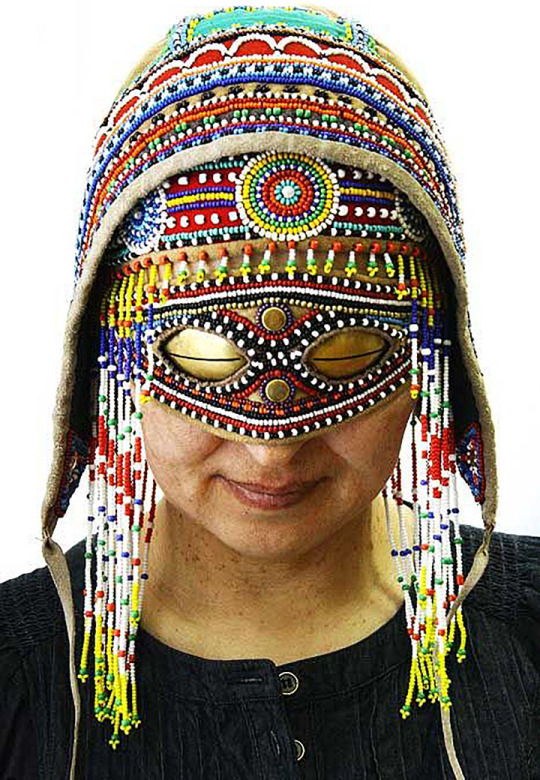



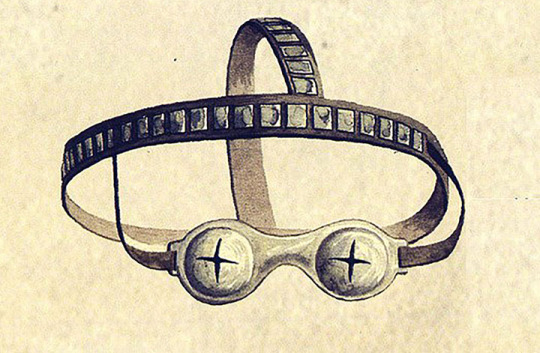
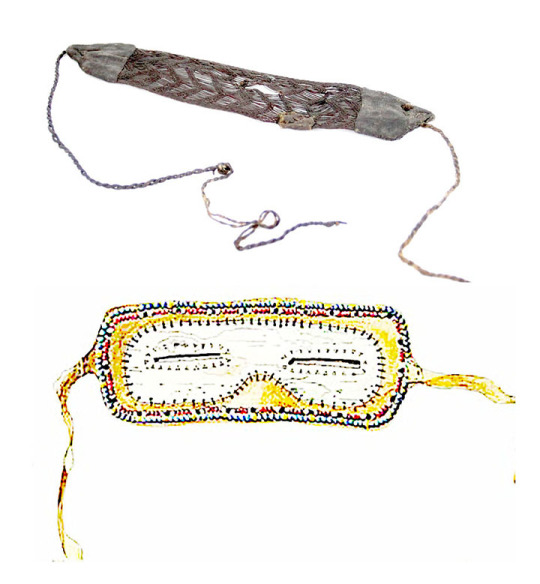


Siberian snow goggles from the Khanty, Nganasan, & Sakha
Toying with an idea here. The concept of the one-eyed Arimaspians has me curious if this was a nickname for people from the north who lived in places where snow goggles may have given the appearance of having a single eye. Given a far enough physical distance and passing through the gossip of enough different languages, by the time this info made it to the Greeks what began as a nickname may have sounded like these people were literal cyclopes. Just a thought. I assume people back then used eye protection from the snow, in some manner, just like people do today. Some of the snow goggles (both modern and historical) do give the appearance of a single giant eye, while others have two eye spots. I wasn't able to find much on this as far as historical info goes, and unfortunately I couldn't find images of the ancient grave finds the article talked about. The oldest of the discovered snow goggles being 2,000 years old from northeast Asia. I'm not sure if the initial black and white sketch is of the ancient goggles or not, the post didn't explicitly say. Below is whatever info I could find on historical snow glasses in Eurasia:
"In ancient times, like today, these goggles were made by skilled masters to combine effectiveness in blotting out the blinding light in some cases looking amazing.
Different ethnic groups across polar regions evolved their own distinctive style in snow goggles.
The most ancient known eyewear belong to the Old Bering Sea culture, the sites of which are located on the both sides of Bering Strait.
The oldest date for the culture - around 400 years BC - was obtained on Russian side, at Ekven graveyard, in Chukotka.
The peak of the culture is considered to be in second and third centuries AD.
At Ekven and also Uelen graveyards snow goggles made of bone were found, dating from the first to the fifth centuries AD.
Some were decorated with carvings, some not, and examples are shown here in these drawings.
Later the snow goggle tradition by Eskimos, for example the Inuits and Yupik, and the Chukchi people.
While there was an obvious practical use for the goggles, a variant of these ‘spectacles’ xxxx is believed to have been used by traditional shamans; for example a pair of goggles without holes of slips was found at Ekve
The Event and Dolgans people turned to metal in making the eyewear with copper or tin or silver goggles inserted into a half-mask made of reindeer skin or other pelt, or, later, cloth obtained from Russian incomers. Decorations with beads was also a feature.
The same type of goggles was also used by other Arctic people such as the Nganasan or Khanty. The British Museum even has some examples.
The tradition continues to this day and is thriving in Yakutia - also known as Sakha Republic, the largest region in the Russian Federation.
Going back in time, the Yakut people used a wide range of materials to make goggles - metal, birch bark, wood, bone, skin, and horsehair.
The goggles created from horsehair comprised strips of intricate net. A surviving 19th century example comes not from Yakutia but Tuva, the mountainous region in southern Siberia, now in a collection in the Irkutsk Museum of Local History.
Most of the metal goggles in Yakut collections are dated from between the 18th and early 20th centuries.
Again, some definitely had ritualistic uses: they were deployed by shamans, and not in everyday day life for use in snow.
Many Yakuts recall that their grandfathers had very simple goggles made of birch bark.
Local historian Prokopy Nagovitsyn said: 'The round shaped silver goggles began to make an appearance in 19th century, when there appeared many rich people.
‘The shape had a symbolic meaning - cross in the circle had been the symbol of the sun since neolithic times.
‘Yet the cross-shaped cuts are convenient not when you are in tundra, but when you, for example, climb steps.’
Most of the older goggles look rather simple - for example a metal strip with the small deepening for the nose and slots for sight. Others have two round metal discs with a slit to see through while blotting out most of the glare; these were fixed into a the mask of skin or fur."
-taken from SiberianTimes
#snow goggles#sunglasses#khanty#nganasan#sakha republic#antiquities#history#yakutia#siberia#arimaspian#british museum
1K notes
·
View notes
Text
Russia, Explained: Siberian Indigenous Population Halves Amid Suicide Epidemic
By Aliide Naylor
April 8, 2021
A suicide epidemic is ravaging indigenous nations in Siberia.
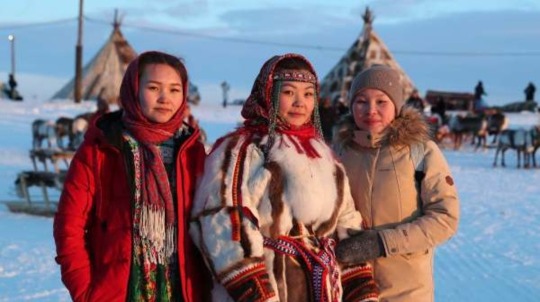
A suicide epidemic is ravaging indigenous nations in Siberia. The Uralic Nganasan community in Siberia’s northern reaches is disappearing at a shocking rate – just three decades ago, there were some 1,300. Now, there are only around 700.
In the Nganasan settlement of Ust-Avam in Krasnoyarsk Krai, there are more suicides than natural deaths. “Six people die here every year. One of these deaths is the result of natural causes. Two or three freeze or die drunk. And two or three kill themselves,” writeNovaya Gazeta special correspondents Elena Kostyuchenko and Yuri Kozyrev after visiting the region.
The community is suffering the devastating effects of global warming, man-made environmental degradation, and severe poverty fuel depression. Out of 359 residents, just 54 have jobs.
“People crack, young people in general break down. The suicide rate is higher among young people. There is no work, nothing. Here you need to pay for lighting, and need to work for food. There is no food, no work, no money,” one young resident says. Her sister also committed suicide, leaving behind an 11-year-old son.
It’s often necessary to rely on anecdotal evidence about indigenous issues. Media reports are sparse and obtaining concrete statistical evidence about indigenous tribes such as the Nganasan is tough. And some deaths may be portrayed as suicides when there is little public information about the facts (for example, the death of one 15-year-old girl, in an uncomfortably termed “relationship” with a 24-year-old adult male police officer wasstyled in 2004 as a Romeo and Juliet story by local press).
The Nganasan are the descendants of semi-nomadic reindeer hunters, with ancient roots and a shamanistic spiritual culture. Even under Peter the Great (in the 17th and 18th centuries) there was a drive to “civilize” Russians in the further-flung regions and catch up with Europe, writes historian Yuri Slezkine. Peter instructed missionaries to find native Siberians and their “seductive false gods-idols and burn them with fire … and destroy their heathen temples”. Such ideas gained greater momentum in the 20th century, and the indigenous people were later forced into reservations under the Soviets in the 1930s. Nomadic civilizations were considered fundamentally incompatible with government-sanctioned lifestyles and these “small nations” of the North were seen as somehow representative of an undesirable past.
The Soviet state collectivized their personal property, including tents, guns and traps, and even reindeer herds. This led to a complete loss of reindeer husbandry and resulted in a steep decline in the reindeer population from the 1950s onwards.
Meanwhile, Soviet enforcement of Russian literacy made the local language almost extinct. Much like practices imposed on indigenous communities in other parts of the world, the Kremlin would take away local kids from their parents and send them to study in boarding schools.
“There, speaking Nganasan was forbidden, and teachers punished them for every Nganasan word they used — beaten with canes, kicked out of the class,” said local linguist Valentin Gusev. Today, Russia is home to 260,000 people from indigenous communities – who constitute just 0.2% of the country’s population. The government officially recognizes 40 separate indigenous groups in the North, Siberia, and the Far East.
The catastrophic impact of climate change in the Russian Arctic limits the Nganasan’s fishing opportunities — their primary food source. Meanwhile, the government continues to restrict hunting, which is a widespread source of tension between the Kremlin and indigenous communities elsewhere across Russia. With a de factoban on hunting, the Nganasans stopped following the routes of wild herds. Local food available for purchase can be out of date or moldy, and chronic alcohol use continues to plague the population.
Aggressive industrial development in the Russian Arctic has massively exacerbated the crisis among the Nganasan. Last year, a Norilsk Nickel (Nornickel) diesel spillbecame the largest human-made fuel spill in Arctic history, after which Russia’s government colludedwith the company (which is the nation’s largest nickel producer) to whitewash the disaster. The spill affected the environment that provided the Nganasan with basic food supplies. “They catch fish; they hunt deer. But there are no fish this year. And the deer left for other lands three years ago,” Kostyuchenko and Kozyrev wrote.
Last year, northern indigenous tribes signed an open letterto US business magnate Elon Musk and Tesla asking him not to purchase any nickel, copper, and other materials from Nornickel in the wake of the disaster. On average, the Norilsk Mining and Metallurgical Combine plant has released 30 tons of metallic dust and heavy metal oxides annually since it began production in the late 1930s, according toresearcher Konstantin B. Klokov.
There has been a recent spikemore generally in tensions between federal authorities and indigenous communities. Some of these nations have mobilized against an over-centralized state, government-backed environmental assaults on their sacred lands, and have demanded the return of their autonomy. In Kalmykia, for example, the majority-Buddhist region has engaged in protests against a Kremlin-appointed mayor. In Buryatia, locals rallied against a rigged election for weeks. And in a case that sent waves across Russia, a Sámi activist filed a complaint with Russia’s Supreme Court last year, after the government denied him the right to hunt without a license.
#indigenous#culture#indigenous russia#indigenous russian#russia#important#fypシ#colonization#fypage#landback#siberian indigenous#siberia#indigenous siberian#siberian#russian imperialism#russian genocide#russian colonization#land back#Nganasan#Uralic
99 notes
·
View notes
Text

Nganasan men, Siberia.
Though related to the Nenets due to their common Samoyedic background - they hunt reindeer. As opposed to herding them like the Nenets do.
11 notes
·
View notes
Photo
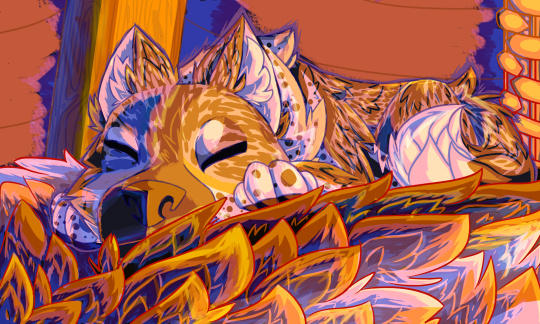
In the freeziest of most northern sub-zero arctic Eurasia where reindeers been raise by aboriginal indigenous ethnics were either a Sami or Samoyedics or Yukaghir or Evenki or Even or Dolgan or more. A useful domestic companion eurasian spitz dogs of Laika family has always helped to serve task for easlyer for them. Even when it nightime, they also allow thier pouch to sleep in for warm.
Software used: Firealpaca
Graphics is a nightmare and didn't turn out the way the artstyle i want to be.
Artstyle inspired from:
- https://www.furaffinity.net/view/43822668/
And - https://www.deviantart.com/katiehofgard/art/Snow-Spirit-720953232
#native#indigenous#aboriginal#arctic#laika#eurasia#samoyed#domestic dog#dog#chum#tent#reindeer skin#warm#Sami#nganasan#enet#evenki#even#yukaghir#selkup#nenet#laavu#dolgan#sleep#slumber#spitz#firealpaca
2 notes
·
View notes
Text
youtube
This piece takes you on at trip through central Siberia, from the throat-singing peoples and beautiful mountains in the south to the arctic tundra and deep shamanic traditions of the north.
This was my biggest project of 2023. I wrote this piece and an essay as my final degree project in composition, all about Siberian indigenousgroups and their music.
The essay (in Swedish) can be found here:
https://urn.kb.se/resolve?urn=urn:nbn:se:oru:diva-106984
#classicalmusic#contemporarymusic#composition#originalcomposition#music#orchestra#orchestralmusic#symphonyorchestra#chamberorchestra#siberia#indigenous#indigenoussiberia#altai#tuva#nganasan#throatsinging#khoomei#kargyraa#sygyt#shaman#shamanism#contrabassoon#bassclarinet#piccolo#youtube#Youtube
1 note
·
View note
Text
ΓΝΩΡΙΖΑΤΕ ΟΤΙ ΣΤΗ ΡΩΣΙΚΗ ΣΙΒΗΡΙΑ ΥΠΑΡΧΟΥΝ ΑΚΟΜΑ ΙΘΧΟΝΙΚΟΙ ΠΟΥ ΔΕΝ ΜΙΛΟΥΝ ΟΥΤΕ ΡΩΣΙΚΑ;
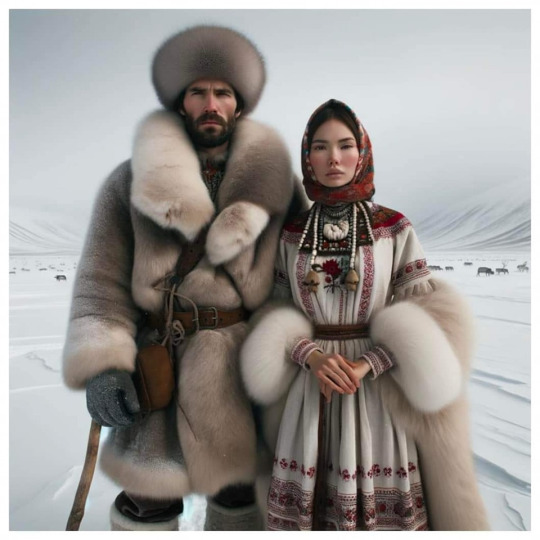
Στις τεράστιες παγωμένες εκτάσεις της βόρειας Σιβηρίας, όπου κυριαρχούν τα κρύα τσιμπήματα και η σιωπή, υπάρχει μια ιθαγενής κοινότητα που έχει αντέξει στη δοκιμασία του χρόνου: οι Nganasan. Ζώντας σε έναν κόσμο τόσο μακρινό και σε τόσο ακραίες συνθήκες, είναι εκπληκτικό να ανακαλύπτουμε ότι υπάρχουν εκείνοι που εξακολουθούν να μην μιλούν ρωσικά, την κυρίαρχη γλώσσα της περιοχής.
Οι Ngananas, πρόγονοι κάτοικοι της χερσονήσου Taymyr στην περιοχή Krasnoyarsk της Ρωσίας, έχουν διατηρήσει μια βαθιά σύνδεση με την πατρίδα τους για πάνω από χίλια χρόνια. Αρχικά από τη λεκάνη του ποταμού Yenisei, επεκτάθηκαν προς τα βόρεια, προσαρμόζοντας και σφυρηλατώντας σχέσεις με άλλες κοινότητες, όπως το Evenki και το Dolgan. Κατά τη διάρκεια των αιώνων, αυτοί οι δεσμοί έχουν εμπλουτίσει και διαφοροποιήσει τις παραδόσεις τους.
Η ζωή της Nganasan περιστρέφεται γύρω από τη φύση. Ανάλογα με το κυνήγι, το ψάρεμα και την εκτροφή ταράνδων για τα προς το ζην, έχουν αναπτύξει δεξιότητες και τεχνικές που τους επιτρέπουν να επιβιώσουν σε ένα από τα πιο αφιλόξενα κλίματα του πλανήτη. Αλλά πέρα από τη φυσική επιβίωση, η πνευματικότητά τους, που έχει τις ρίζες του στον σαμανισμό και τις ανιμιστικές πεποιθήσεις, τους δίνει μια ιδιαίτερη σύνδεση με τον κόσμο γύρω τους. Κάθε ήχος του ανέμου, κάθε κίνηση ενός ζώου, είναι ένα μήνυμα, ένα σημάδι, ένα πνεύμα.
Παρά την κυριαρχία των ρωσικών στην περιοχή, η γλώσσα Nganasan, μέρος της οικογένειας των ουραλικών γλωσσών, είναι ακόμα ζωντανή. Ωστόσο, κινδυνεύει, καθώς πολλοί νέοι επιλέγουν να μάθουν ρωσικά αντί για τη μητρική τους γλώσσα. Ωστόσο, κάποιοι αντιστέκονται, επιλέγοντας να μην ταιριάζουν στη σύγχρονη κοινωνία.
Όσον αφορά την τέχνη, οι Ngananas επιδεικνύουν εντυπωσιακή δεξιότητα στη σκάλισμα από ελεφαντόδοντο και στην κατασκευή ενδυμάτων, όπου κάθε σχέδιο λέει μια ιστορία, μύθο ή παράδοση. Επίσης, βραχογραφίες που ανακαλύφθηκαν στη χερσόνησο Taymyr μας προσφέρουν μια ματιά στο παρελθόν της, παρουσιάζοντας σκηνές κυνηγιού, ζώων και καθημερινής ζωής.
Ωστόσο, η νομαδική ζωή είναι προκλητική. Με την εποχική μετανάστευση μετά από κοπάδια ταράνδων, οι Ngananas έχουν υιοθετήσει έναν ρευστό τρόπο ζωής, χρησιμοποιώντας σκηνές που ονομάζονται «chum» ή «yaranga», κατασκευασμένες από ξύλο και δέρματα ζώων, που συναρμολογούνται και αποσυναρμολογούνται εύκολα.
Παρά τη δύναμη και την προσαρμοστικότητά τους, οι Ngananas αντιμετωπίζουν απειλές στον σύγχρονο κόσμο. Η αστικοποίηση, η κλιματική αλλαγή και η απώλεια ευκαιριών θέτουν σε κίνδυνο τον παραδοσιακό τρόπο ζωής τους. Ωστόσο, η ανθεκτικότητα και η αποφασιστικότητά του αποτελούν έμπνευση.
Η φωτιά, απαραίτητη για την επιβίωσή της, έχει επίσης ένα βαθύ νόημα στον πολιτισμό της. Παρέχει θερμότητα και φως, προστατεύει από τα κακά πνεύματα και είναι κεντρικός στις θρησκευτικές τελετουργίες. Επίσης, οι τάρανδοι, πέρα από πηγή τροφής και ένδυσης, λατρεύονται, γιορτάζονται σε πανηγύρια και τελετουργίες.
Οι Ngananas είναι μια ζωντανή μαρτυρία για την πλούσια πολιτιστική ταπετσαρία του κόσμου μας. Καθώς αντιμετωπίζουν προκλήσεις στη σύγχρονη εποχή, είναι επιτακτική ανάγκη να υποστηριχθούν και να διατηρηθούν οι παραδόσεις τους. Είναι μια υπενθύμιση της σημασίας της συνύπαρξης και της εκτίμησης της διαφορετικότητας σε έναν συνεχώς μεταβαλλόμενο κόσμο.

🧡 Vicky !
0 notes
Text
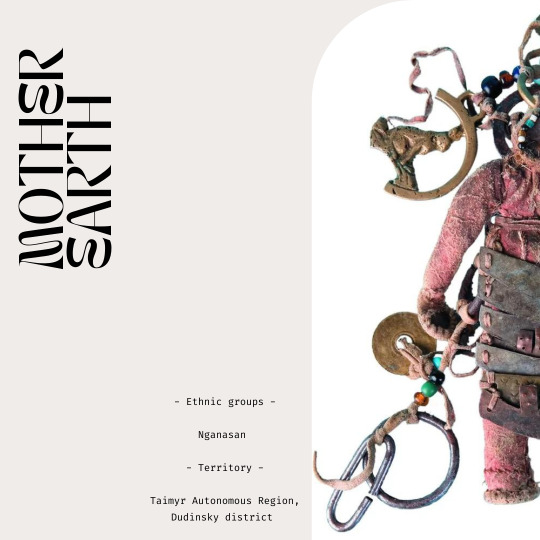

#archive collectiona#archive#archeology lover#archeology#archeologi#archeologia#italian archive#nature#anthropology#antiquities#design#graphic#graphic design#graphisme#mother earth#nganasan#idol#shaman
0 notes
Text
youtube
Song: Séance Chamanique De L'Ours (Shamanic Bear Session)
Artists: Delsjumjaku Demnimeevič Kosterkin, Boris Djukhodovič Kosterkin, Sandimjaku Cajkhoreevna Kosterkina
Album: Sibérie 1: Chants Chamaniques Et Narratifs De L'Arctique Sibérien (Shamanic and Narrative Songs of the Siberian Arctic)
0 notes
Text
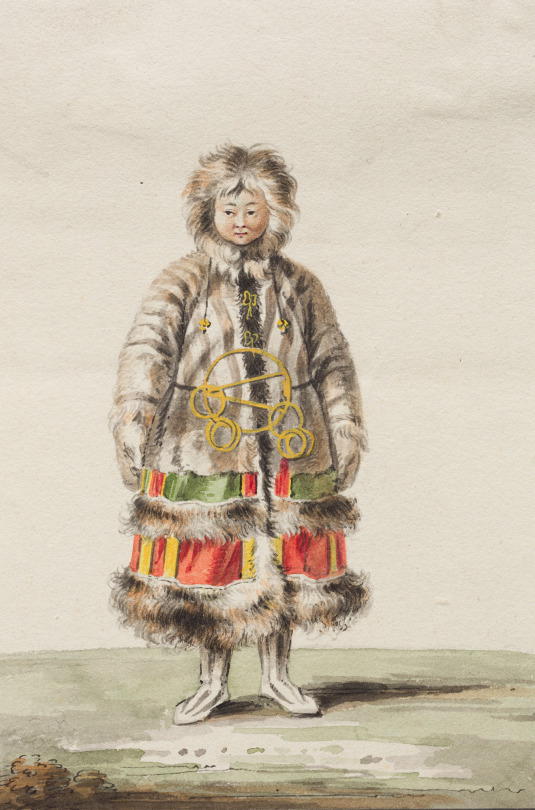
Emel'jan Korneev (1780–1843)
"Samoyed girl in festive costume", ca. 1810
Münchner Stadtmuseum
#Outfit looks Enets or Nganasan to me but I'm not qualified to make that call so leaving title as-is#emel'jan korneev#emeljan korneev#indigenous#siberia
56 notes
·
View notes
Text
holy shit did you know that [some topic on which i just watched a youtube video that i got randomly recommended] . literally how is nobody ever talking about this. life changing.
#for some reason i really like to watch random videos of folks talking about languages#especially if its about some endangered language (nganasan this time )#viky stuff
0 notes
Text
Sorry I'm going to attack some of you viciously at the moment:
One of the dangers of reblogging a meme poll by a linguistics doer to my blog followed by a bunch of people who think about twentieth century eastern european politics too much is that they'll answer what they think is the funny meme answer when actually it's a normie answered compared to the true meme shit and they are making themselves look normie. Like when when redditors larping as their own ww2 enthusiast dads talk about hitler's failed art career. WE KNOW. in fact we know secret things you haven't even heard about. obviously santa was nganasan.
30 notes
·
View notes
Text
Crossposting from Twxttxr: some interesting news about ongoing research by colleagues, from a workshop "Diversification of Uralic" just this Thursday and Friday
Do the Permic languages have loanwords from Old Norse? e.g. ONo. ár ~ Komi & Udmurt ar 'year'. This would've been sensible during the brief time when Norsemen originally from Sweden were in charge of trade along the Volga and settling in inner Russia, forming the Rus' (later Slavicized, but as we know from Byzantine sources they remained Norse for centuries) — and also the Norwegians too were known to conduct exploration + trade along the Barents Sea at the time, our oldest written reports of "Bjarmia" come from them after all.
Do the Finnic languages have loanwords already from Pre-Proto-Germanic into Pre-Proto-Finnic? My first reply would've been "yes surely", this has been discussed for half a century and there's dozens of etymologies out by now. Turns out though that there's still a lot of room for skepticism if we try to assemble a big picture. Most of these could be (and have been proposed by other analyses) to be proper Germanic after all, or from some non-Germanic kind of Indo-European, or even incorrect. There is unambiguous evidence I think at least of loans lacking *ā > *ō, but that's already though to be one of the latest common Germanic innovations, perhaps barely post-PG.
[Follow-up question: do we even know where Pre-Proto-Germanic was spoken? might not have been anywhere convenient for contacts with Pre-Proto-Finnic.]
— A few similar problems also in the less discussed supposed layer of Proto-Balto-Slavic or pre-BSl. loans, but by areal considerations it seems obvious to me there must've been Uralic/IE contact somewhere in the Russian forest belt for ages already, even if it might not have left enough evidence to clearly distinguish from things like pre-Indo-Iranian loans.
Do the Samic languages have loanwords that are not from any historically attested branch of Scandinavian, but some sort of a lost variety entirely? This could be an explanation for an unexpected sound correspondence *j → *ć in many loans; it might also explain some loans that look surprizingly archaic, e.g. lacking any reflection of Siever's Law. One example showing both is indeed *Tāńćə 'Norse', from some sort of a *Danji- variant of Proto-Germanic *Daniz.
Several new hypotheses on the history of of sibilants in Ugric, adding to the growing tally of evidence that traditionally reconstructed *s > *θ and *ś > *s "in Proto-Ugric" are actually later developments. A paper supposed to be coming out soon!
No linguistic evidence so far, but a 1670 travelogue by de La Martinière appears to still report seemingly pre-Uralic populations along the Barents Sea coast — and even on Novaya Zemlya, traditionally thought to have been uninhabited (as reported by other early modern explorers) before some Tundra Nenets briefly settled there in mid 19th century. Apparently there's been no real archeological investigation, but also at least two stone labyrinths are known as signs that humans still must've at least visited there sometime in the past.
[By current knowledge, labyrinths from Sweden and Finland have mostly been built in late medieval and early modern times though, so they don't suggest especial antiquity either. Could the ones on NZ in fact have been left behind by some of these historical Northwest European expeditions?]
Various discussion also on the development of Samoyedic. Nothing particularly all-new (maybe on Nganasan, more on that in a PhD thesis to appear later this year though), but a few main results include 1. clear recognition that there is no "North Samoyedic" group (as has been suspected for several years now), 2. confirmation that there is regardless a narrower Nenets–Enets group, and 3. some development of a model where all three of Nenets, Enets and Nganasan may have moved to the tundra zone independently from further down south (as is certainly the case for Northern Selkup, the most recent northern expansion of Samoyedic speakers).
#historical linguistics#loanwords#language contact#archeology#ethnohistory#uralic#finnic#samic#permic#samoyedic#germanic
28 notes
·
View notes
Text
Only a few hundred native Nganasan speakers are left. Beautiful language and people.
#indigenous#indigenous russian#culture#indigenous russia#russia#important#colonization#fypシ#fypage#landback#decolonize#Nganasan#native people#Native#indigenous people#endangered languages#endangered#fyp#foryou#video
43 notes
·
View notes
Text
About my Siberia ocs...
So I think it's important to balance their characterisation in a way in which they are distinctive characters with interesting personalities and backstories but also acknowledges the challenges they face without making their entire character essentially "They're sad all the time because of Russia" or "Stop talking about their struggles under Russia I don't like politics."
I think both are problematic however I find the latter to be far more distasteful because well. This is a nation personification OC we're talking about and not only that, they're essentially nations within a nation (Russia) by virtue of colonisation and so are minority groups within the larger nation. Hell - because of displacement and immigration from European Russia , a lot of these groups are minorities within their own lands. It's a special case when dealing with minority groups/occupied people personifications and it's particularly egregious when someone wants to forgo any kind of acknowledgement of these power imbalances yet still insists that their interpretation is sensitive.
I've seen some pretty bad OCs of Siberian groups which are the product of the creator going "I hate politics stop talking about politics!" or, an almost direct quote, "I hate when people shove politics into historical hetalia." Which... Is an interesting take to say the least considering how history feeds into politics and vice versa. Historical hetalia is a beast in an of itself and is one of the only hetalia communities/bubbles in which "no politics" will get you laughed out the door from what I've seen considering *gestures to my previous statement*. If you've ever taken a history course - you'll know how much history and politics are intertwined.
This is how you get interps which consists of the likes of "Russia was wandering around the empty lands of Siberia" which not only blatantly disregards the brutality of the Russian colonisation of Siberia but also promotes the concept of "Terra Nullius" or "Virgin Land". I'm quoting myself from an even bigger post I have in store which focuses on anti Mongolian sentiment however stereotypes about Mongolians and Siberian groups often overlap because of their placement in Northern Asia, hence why it applies to both,
"In addition, to hone in on Mongolia being an "untouched, pristine" land - this is also a common trope that is launched towards traditionally nomadic "unsettled groups” (such as Siberian and Native American groups). The concept of "Terra Nullius", a Latin word meaning "nobody's land". It completely disregards the presence and rights of the people who inhabit the land and has been historically used to justify the colonisation and displacement of such groups - their land belonged to "nobody" so it was essentially up for grabs...It divorces the people from their landscape and paves the way for dangerous misconceptions and justifications to blossom.
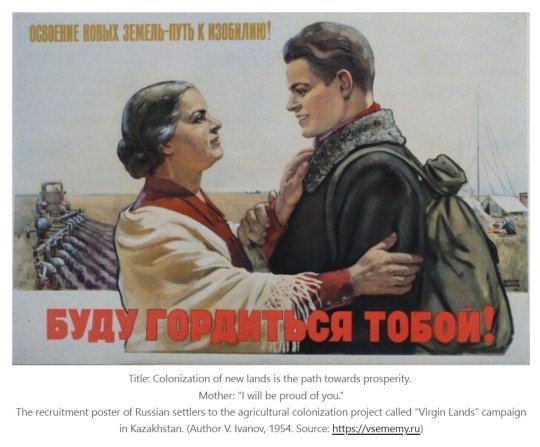
Here is an example of "Terra Nullius" in action in a Russian propaganda poster, encouraging Russians to move to Kazakhstan."
Or interps such as "[Siberian group] has forgiven Russia for everything he did/most things he did and is in love with him" which implies that the mistreatment of the Siberian groups is merely something in the past when it is in fact ongoing. The mistreatment of Siberian groups such as the Sakha, Buryats, Chukchi and Tuvans has been all the more highlighted in their disproportionate mobilisation in the invasion of Ukraine - and the heaps of scapegoating that was subsequently shovelled onto them.
That's not to say ethnic minority soldiers in the Russian army shouldn't be held accountable for their crimes - however that and the fact that they themselves are victims of Russian imperialism can both exist as true statements. The scapegoating is so bad that even Pope Francis joined in, blaming the brunt of the war crimes committed onto "Non Russians" such as Buryats and Chechens, as they do not come from "Russian culture."
Back to my main point... I think the resistance to do research on and publicly acknowledge how these groups live under Russia and what kind of struggles they face in some kind of bid to "not paint them as victims!!11" is sorely misinformed and ignorant. Because well. They are victims.
Not in the sense that you should portray them as sad, pitiful, weak little meow meows but in the sense that yes they are living under Russian occupation and are an occupied people who's been subjected to centuries of Russification, and so compared to making an OC of Mongolia who is an independent nation state at least I think there is far less room to be hauling around "leave politics out of historical hetalia!" "don't talk to me about politics!" "stop victimising them!!" because then it leads to tone deaf interpretations such as "They've forgiven Russia for everything and is in love with him ♥️💖", "Russia is actually [Siberia groups] father", "Here is my singular Siberia OC who represents ALL Siberian groups and by the way Russia is their father" (yes these are all real interpretations I've seen and I've made a separate really strongly worded post ranting about it) and worse. I mean I've literally seen an "aph Siberia oc" who was Russia and France's love child. Terra Nullius executed Hetalia-style.
I don't really think I need to elaborate on why a singular Siberia OC is problematic - Siberia is filled with a myriad of different groups who speak different languages, have different origins and ways of lives and practices, different religions, who've experienced eras of peace and conflict with each other, etc and yeah to shove them all into one personification is an erasure of the sheer diversity that is in Siberia. I definitely don't need to elaborate on why making Russia a father to any of these groups is problematic, to say very the least.
On the point of "don't only portray them in a victimising lense", I think making Siberian groups all depressed all the time is also a Russia-centric perspective. Of course it's ignorant at best to not acknowledge their shared suffering because of Russia however when this point and this point alone is central to their character I believe in a way that it strips them of their autonomy and ability to feel things and do things outside of Russia's gaze. There is absolutely a lot of joy to be had despite their current situation, perhaps even in spite of their current situation. It's ok to give them odd quirks and put them in funny situations as well as acknowledge that they are an occupied people and approach that territory carefully when need be.
For example, I made my Buryatia bubbly and loud but made my Tuva a bit more deadpan because I see them as a pair who often associate with each other and I think the dynamic is funny. I also made Buryatia an overbearing "husband" to Soyot who is perpetually tired™ from all the se- .
I made a crack dynamic between Sakha, Evenkia and Dolgan where Evenkia was Sakha's teacher at first but then became a deadbeat dad leaving Sakha to primarily raise Dolgan, thus Dolgan takes after Sakha and is uh lawyermaxxing👍. Yukaghir is the little old lady of the group who is often forgetful but very nifty and Chukotka acts like a big sister to people which Koryak (who I see as her brother) always finds annoying and they often bicker. Ket is on the slightly edgy side and is extremely particular about his routines and Nganasan terrifies Nenet because he eats reindeer whereas Nenet doesn't.
All of these quirks/ more lighthearted interpretations and "they are an occupied people under Russia" can coexist. One should not be thrown out for the sake of the other.
I think there's also problem - though I've seen this far less, in making Siberia ocs purely as a middle finger at Russia. As in, you made the OC because you wanted to say loud and proud FUCK RUSSIA which well yeah, fuck Russia, but I highly doubt your interest in this group lies outside of wanting to #own the Russians which is dehumanising in and of itself. At least pretend to care about the history and culture instead of using an entire group of people to make a virtue-signally oc purely to try and upset some Russians.
Anyways yeah Siberia 👍
#hetalia#hetalia world stars#hetalia world series#hetalia world twinkle#Aph Siberia#Hetalia Siberia#Hws Siberia#Hws Sakha#Aph Sakha#Aph Buryatia#Hws Buryatia#Hws Tuva#Aph Tuva#Aph Soyot#Hws Soyot#Hws Evenk#Aph Evenk#Hws Dolgan#Aph Dolgan#Aph Yukaghir#Hws Yukaghir#Aph Chukotka#Hws Chukotka#Hetalia Chukotka#Aph Koryak#Hws Koryak#Aph Ket#Hws Ket#Hws nganasan#Hws Nenet
33 notes
·
View notes
Text
Starshine is somewhere among Mongolian, Nganasan, Saami, Yakut, Buryat, Yupik, & Inuit. Avoiding outright using mine irl ethnic own ties, but related groups. So hard to choose which tho.
#distant cousin vibes#yuurivoice star#yuurivoice faust#yuurivoice oc#either from both sides of the Atlantic#or both sides of the Pacific
12 notes
·
View notes
Text
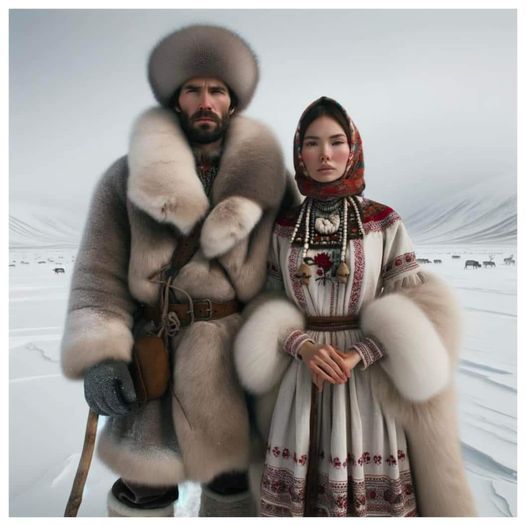
¿SABÍAS QUE EN LA SIBERIA RUSA AÚN EXISTEN INDÍGENAS QUE NI SIQUIERA HABLAN RUSO? Aquí te lo cuento
En las vastas extensiones heladas del norte de Siberia, donde el frío muerde y el silencio reina, existe una comunidad indígena que ha resistido la prueba del tiempo: los Nganasan. Viviendo en un mundo tan distante y en condiciones tan extremas, es sorprendente descubrir que hay quienes aún no hablan ruso, el idioma dominante de la región.
Los Nganasan, habitantes ancestrales de la península de Taymyr en la región de Krasnoyarsk, Rusia, han mantenido una conexión profunda con su tierra natal durante más de mil años. Originarios de la cuenca del río Yenisei, se expandieron hacia el norte, adaptándose y forjando relaciones con otras comunidades, como los Evenki y los Dolgan. A lo largo de los siglos, estos lazos han enriquecido y diversificado sus tradiciones.
La vida de los Nganasan gira en torno a la naturaleza. Dependiendo de la caza, la pesca y la cría de renos para subsistir, han desarrollado habilidades y técnicas que les permiten sobrevivir en uno de los climas más inhóspitos del planeta. Pero más allá de la supervivencia física, su espiritualidad, arraigada en el chamanismo y las creencias animistas, les brinda una conexión especial con el mundo que les rodea. Cada sonido del viento, cada movimiento de un animal, es un mensaje, una señal, un espíritu.
A pesar de la dominancia del ruso en la región, el idioma Nganasan, parte de la familia de lenguas urálicas, sigue vivo. Sin embargo, se encuentra en peligro, con muchos jóvenes optando por aprender ruso en lugar de su lengua materna. Aun así, algunos resisten, eligiendo no introducirse en la sociedad moderna.
En términos de arte, los Nganasan demuestran una habilidad impresionante en el tallado de marfil y en la confección de prendas, donde cada diseño cuenta una historia, un mito o una tradición. Además, las pinturas rupestres descubiertas en la península de Taymyr nos ofrecen un vistazo a su pasado, mostrando escenas de caza, animales y vida cotidiana.
Sin embargo, la vida nómada presenta desafíos. Con la migración estacional siguiendo a los rebaños de renos, los Nganasan han adoptado un estilo de vida fluido, utilizando tiendas de campaña llamadas “chum” o “yaranga”, hechas de madera y pieles de animales, fáciles de montar y desmontar.
A pesar de su fortaleza y adaptabilidad, los Nganasan enfrentan amenazas en el mundo moderno. La urbanización, el cambio climático y la pérdida de oportunidades están poniendo en peligro su modo de vida tradicional. Sin embargo, su resiliencia y determinación son una inspiración.
El fuego, esencial para su supervivencia, también tiene un significado profundo en su cultura. Proporciona calor y luz, protege de espíritus malignos y es central en rituales religiosos. Además, los renos, más allá de ser una fuente de alimento y vestimenta, son venerados, celebrados en festivales y rituales.
Los Nganasan son un testimonio viviente de la rica rareza cultural de nuestro mundo. A medida que enfrentan desafíos en la era moderna, es imperativo que se les apoye y se preserven sus tradiciones. Son un recordatorio de la importancia de la coexistencia y de valorar la diversidad en un mundo en constante cambio.
11 notes
·
View notes